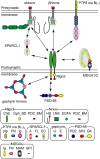Neuroligin-3: A Circuit-Specific Synapse Organizer That Shapes Normal Function and Autism Spectrum Disorder-Associated Dysfunction
- PMID: 34690695
- PMCID: PMC8526735
- DOI: 10.3389/fnmol.2021.749164
Neuroligin-3: A Circuit-Specific Synapse Organizer That Shapes Normal Function and Autism Spectrum Disorder-Associated Dysfunction
Abstract
Chemical synapses provide a vital foundation for neuron-neuron communication and overall brain function. By tethering closely apposed molecular machinery for presynaptic neurotransmitter release and postsynaptic signal transduction, circuit- and context- specific synaptic properties can drive neuronal computations for animal behavior. Trans-synaptic signaling via synaptic cell adhesion molecules (CAMs) serves as a promising mechanism to generate the molecular diversity of chemical synapses. Neuroligins (Nlgns) were discovered as postsynaptic CAMs that can bind to presynaptic CAMs like Neurexins (Nrxns) at the synaptic cleft. Among the four (Nlgn1-4) or five (Nlgn1-3, Nlgn4X, and Nlgn4Y) isoforms in rodents or humans, respectively, Nlgn3 has a heterogeneous expression and function at particular subsets of chemical synapses and strong association with non-syndromic autism spectrum disorder (ASD). Several lines of evidence have suggested that the unique expression and function of Nlgn3 protein underlie circuit-specific dysfunction characteristic of non-syndromic ASD caused by the disruption of Nlgn3 gene. Furthermore, recent studies have uncovered the molecular mechanism underlying input cell-dependent expression of Nlgn3 protein at hippocampal inhibitory synapses, in which trans-synaptic signaling of specific alternatively spliced isoforms of Nlgn3 and Nrxn plays a critical role. In this review article, we overview the molecular, anatomical, and physiological knowledge about Nlgn3, focusing on the circuit-specific function of mammalian Nlgn3 and its underlying molecular mechanism. This will provide not only new insight into specific Nlgn3-mediated trans-synaptic interactions as molecular codes for synapse specification but also a better understanding of the pathophysiological basis for non-syndromic ASD associated with functional impairment in Nlgn3 gene.
Keywords: autism (ASD); cell adhension molecules; development; excitatory synaptic activity; excitatory/inhibitory balance; inhibitory synaptic connection; neuroligin 3 mutation; trans-synaptic adhesion molecule.
Copyright © 2021 Uchigashima, Cheung and Futai.
Conflict of interest statement
The authors declare that the research was conducted in the absence of any commercial or financial relationships that could be construed as a potential conflict of interest.
Figures




Similar articles
-
Regulation of NLGN3 and the Synaptic Rho-GEF Signaling Pathway by CDK5.J Neurosci. 2023 Nov 1;43(44):7264-7275. doi: 10.1523/JNEUROSCI.2309-22.2023. Epub 2023 Sep 12. J Neurosci. 2023. PMID: 37699715 Free PMC article.
-
Neuroligin3 splice isoforms shape inhibitory synaptic function in the mouse hippocampus.J Biol Chem. 2020 Jun 19;295(25):8589-8595. doi: 10.1074/jbc.AC120.012571. Epub 2020 May 7. J Biol Chem. 2020. PMID: 32381505 Free PMC article.
-
Canonical versus non-canonical transsynaptic signaling of neuroligin 3 tunes development of sociality in mice.Nat Commun. 2021 Mar 23;12(1):1848. doi: 10.1038/s41467-021-22059-6. Nat Commun. 2021. PMID: 33758193 Free PMC article.
-
Neuroligins and Neurodevelopmental Disorders: X-Linked Genetics.Front Synaptic Neurosci. 2020 Aug 11;12:33. doi: 10.3389/fnsyn.2020.00033. eCollection 2020. Front Synaptic Neurosci. 2020. PMID: 32848696 Free PMC article. Review.
-
The neuroligins and the synaptic pathway in Autism Spectrum Disorder.Neurosci Biobehav Rev. 2020 Dec;119:37-51. doi: 10.1016/j.neubiorev.2020.09.017. Epub 2020 Sep 28. Neurosci Biobehav Rev. 2020. PMID: 32991906 Review.
Cited by
-
Autism Spectrum Disorder with Epilepsy: A Research Protocol for a Clinical and Genetic Study.Genes (Basel). 2023 Dec 31;15(1):61. doi: 10.3390/genes15010061. Genes (Basel). 2023. PMID: 38254951 Free PMC article.
-
Neuroligin-3-Mediated Synapse Formation Strengthens Interactions between Hippocampus and Barrel Cortex in Associative Memory.Int J Mol Sci. 2024 Jan 5;25(2):711. doi: 10.3390/ijms25020711. Int J Mol Sci. 2024. PMID: 38255783 Free PMC article.
-
Inferring neuron-neuron communications from single-cell transcriptomics through NeuronChat.bioRxiv [Preprint]. 2023 Jan 16:2023.01.12.523826. doi: 10.1101/2023.01.12.523826. bioRxiv. 2023. Update in: Nat Commun. 2023 Feb 28;14(1):1128. doi: 10.1038/s41467-023-36800-w. PMID: 36712056 Free PMC article. Updated. Preprint.
-
Analyses of Human Genetic Data to Identify Clinically Relevant Domains of Neuroligins.Genes (Basel). 2024 Dec 14;15(12):1601. doi: 10.3390/genes15121601. Genes (Basel). 2024. PMID: 39766868 Free PMC article. Review.
-
Auditory cortical neurons are recruited to encode fear signals and anxiety by neuroligin-3-mediated synapse formation.Transl Psychiatry. 2025 Apr 11;15(1):140. doi: 10.1038/s41398-025-03357-9. Transl Psychiatry. 2025. PMID: 40216755 Free PMC article.
References
-
- American Psychiatric Association. (2013). DSM-5, Diagnostic and Statistical Manual of Mental Disorders, 5th Edn. Arlington, VA: American Psychiatric Association. 10.1176/appi.books.9780890425596 - DOI
Publication types
Grants and funding
LinkOut - more resources
Full Text Sources

